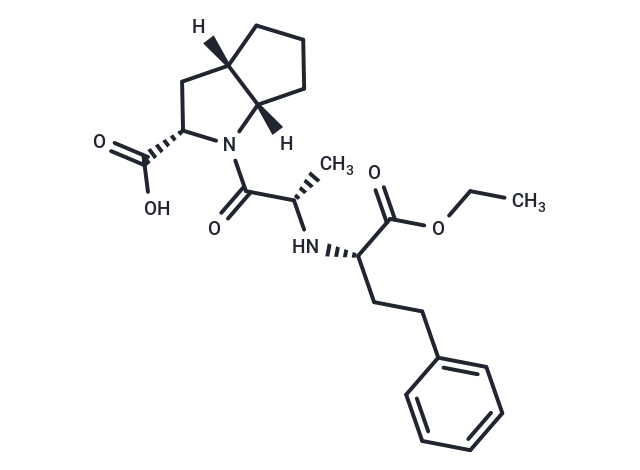Shopping Cart
- Remove All
 Your shopping cart is currently empty
Your shopping cart is currently empty

Ramipril (Altace) is a long-acting angiotensin-converting enzyme inhibitor. It is a prodrug that is transformed in the liver to its active metabolite ramiprilat.

| Pack Size | Price | Availability | Quantity |
|---|---|---|---|
| 100 mg | $33 | In Stock | |
| 500 mg | $52 | In Stock | |
| 1 g | $94 | In Stock | |
| 2 g | $148 | In Stock | |
| 1 mL x 10 mM (in DMSO) | $58 | In Stock |
| Description | Ramipril (Altace) is a long-acting angiotensin-converting enzyme inhibitor. It is a prodrug that is transformed in the liver to its active metabolite ramiprilat. |
| Targets&IC50 | ACE:5 nM |
| In vitro | In spontaneously hypertensive rats, Ramipril significantly inhibits both aortic and pulmonary ACE (ACE Angiotensin Converting Enzyme) activity with an IC50 of approximately 5 mg/kg, without affecting cerebral ACE. When administered slowly, Ramipril lowers blood pressure similar to its effect in vitro on HUVECs (Human Umbilical Vein Endothelial Cells), and compared to other ACE inhibitors, it notably reduces the apoptosis rate induced by lipopolysaccharide. In spontaneously hypertensive rats, Ramipril suppresses systolic blood pressure (SBP) with an IC50 of 1.97 mg/kg. When used in conjunction with AT1 receptor blockers, it synergistically enhances the reduction in SBP. Furthermore, in rats treated with bone morphogenetic protein, Ramipril inhibits beta-cell dysfunction by decreasing monocyte/macrophage permeability, apoptosis, and fibrosis, while also reducing the expression of growth factor genes, the Renin-Angiotensin System (RAS), and inflammatory molecules. |
| In vivo | Long-term treatment of primary human endothelial cells with Ramipril increases ACE expression, an effect that is blocked by the JNK inhibitor SP600125. In serum-starved endothelial cells in vitro, Ramipril does not promote apoptosis. When applied to cultured endothelial cells, Ramipril enhances the activity of CK2 associated with ACE and increases phosphorylation at the ACE Ser1270 site. However, in cells lacking ACE or possessing the S1270A ACE mutation, Ramipril fails to stimulate nuclear accumulation of c-Jun or activate JNK. |
| Cell Research | The HUVECs are pretreated with the active metabolites of Ramipril for 24 hours. A serum deprivation method is used to induce apoptosis in the presence of Ramipril for an additional 24 hours. The rate of apoptosis is then determined using flow cytometry with two makers annexinV fluorescein isothiocyanate (FITC+) and propidium iodide (PI).(Only for Reference) |
| Alias | Tritace, HOE-498, Carasel, Altace |
| Molecular Weight | 416.51 |
| Formula | C23H32N2O5 |
| Cas No. | 87333-19-5 |
| Smiles | C([C@@H](N[C@@H](CCC1=CC=CC=C1)C(OCC)=O)C)(=O)N2[C@@]3([C@](C[C@H]2C(O)=O)(CCC3)[H])[H] |
| Relative Density. | 1.200 g/cm3 (Predicted) |
| Storage | Powder: -20°C for 3 years | In solvent: -80°C for 1 year | Shipping with blue ice. | |||||||||||||||||||||||||||||||||||
| Solubility Information | DMSO: 50 mg/mL (120.05 mM), Sonication is recommended. Ethanol: 41.7 mg/mL (100.12 mM), Sonication is recommended. | |||||||||||||||||||||||||||||||||||
Solution Preparation Table | ||||||||||||||||||||||||||||||||||||
Ethanol/DMSO
| ||||||||||||||||||||||||||||||||||||

Copyright © 2015-2025 TargetMol Chemicals Inc. All Rights Reserved.